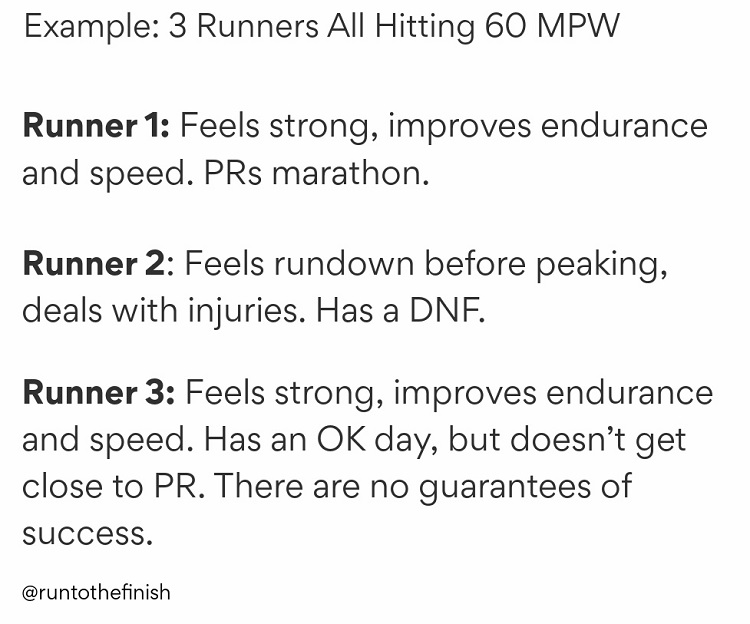One of the most common questions most runners ask me as a running coach is, ‘how often should I run?’. Seriously, new runners, long time runners, it’s something that we’re often pondering when looking at our current goals and quite often comparing it to what we see others doing who might be achieving similar goals

The answer to this question is not as simple as it may seem. Figuring out the right running frequency is key to meeting your fitness goals without risking burnout or injuries.
Whether you’re just starting out or trying to figure out how to maintain fitness between races, this inevitable question definitely keeps popping up.
And along with that, other questions like how many days for strength training and rest are important, and what’s generally considered best practice.
As a running coach, I’m able to dive deep into the answer for those in our group program or with custom training plans , and of course, that’s my preferred way to answer because it’s PERSONALIZED to you.
These questions surround the fundamental concept of volume and frequency in training, i.e., how much you run in terms of weekly mileage, and how often you run in terms of the number of days per week.
In this article, we’ll address both of these aspects in terms of different types of runners and also talk more about the factors that influence running frequency. You’ll learn everything you need to know about how often you should run, and when it’s time to take a break from hitting the pavement.
Want to learn more? Let’s jump right in!
8 Factors That Influence Running Frequency
The answer to how often you should run is going to depend, but if you want to run your first 5K, you might easily get by with just 3 days of running per week.
Meanwhile, if you’re wanting to run your first marathon it’s ideal to work up to 5 days per week (though some do great on 4 days…I told you it’s complicated).
This is just one example, so you’re going to want to consider certain factors that influence running frequency.
One thing, I will say upfront is I do NOT love running streaks or running every day. You can click that to read all about why, but for today let’s say it’s overkill most of the time.
Let’s look at each of these factors in more detail.

#1 Current Goals
The ideal running volume and frequency will be determined by your goals. Are you gearing up for a race? If so, what distance will you be running?
If you want to run your first 5K, you might easily get by with just 3 days of running per week, meanwhile, if you’re wanting to run your first marathon it’s ideal to work up to 5 days per week.
Longer races, in general, need longer training runs, which frequently include running the majority of the week with a greater overall training volume.
Other things to consider when it comes to your goals include the reason why you got into running in the first place. So, why are you running? Do you run to improve your health? Are you mostly running to relieve stress?
All these aspects will play into determining your running frequency. So go over these and consider them while we answer the question of how often you should run.
Running Volume for Different Races:
#2 Injury History and Risk
This is an important one. Do you get shin splints every time you start running? Then you’re likely diving in too fast. The same can be said for most running injuries.
Running comes with a ton of benefits, but running optimally is also about improving your health. Which means, not getting you injured!
Injury-prone runners, or those currently rehabbing an injury or trying to alleviate issues as a result of a previous injury, should run less frequently and do shorter runs. Do more cross training and all the PT to strengthen weak areas.
So knowing your body, be smart about starting slow with just 2 days per week and spend another few days walking or cycling, giving your body plenty of time to adapt to the stress of running.
- Frequent injuries – see a Sports PT to diagnosis weaknesses or gait issues
- Spend consistent time doing core workouts, they’re a prime driver of most running injuries
- Remember that everyone is different, you may not need the volume a friend does
- Ease in to speed workouts
#3 Time and Availability
Time is definitely an unavoidable factor. The biggest excuse from any runner about why they skip the warm-up or don’t do the injury preventing hip work is time.
It’s also the main reason a new runner might find themselves swearing to run every morning at 6AM and instead only making it happen once a week.
We all have busy lives these days, so your schedule may only allow for a few early runs per week, or your run time may be limited to what you can get in during your lunch break at work.
Whatever the situation may be, the conflicting demands of life restrict many runners’ training frequency.
Checkout these tips from busy marathon runners >>
#4 Current Fitness Level
Your current fitness level is also an important factor, and it differs from your experience level.
For example, if you’re new to running, but have been exercising consistently in another form like biking, hiking, or swimming, you should have a decent cardiovascular fitness base.
This allows you to tolerate more running or increase your training volume more rapidly.
On the other hand, if you’re an experienced runner who’s been away from the sport for a lengthy period of time, maybe due to an injury, pregnancy, or just life getting in the way, you’ll want to be more careful. Similar to beginners, rather than what your previous miles would suggest you can run.
#5 Experience Level
If you’ve been running for a long time, you should not be surprised that you can run more miles safely than someone who is just starting out.
Beginners need a lot of time to build up their endurance and give their bodies time to adapt to the physical demands of running, especially their musculoskeletal system.
In fact, the cardiovascular system gets stronger and adapts faster than the muscles, bones, tendons, ligaments, and other parts of the body can.
It’s important to remember that even though it appears that your body is capable of running further or for longer periods of time, it needs time. The steady progression in your training plan is a conscious effort to ensure that your body receives the recovery it needs to adapt to high-impact activity such as running.

#6 Age
Of course, there are always exceptions to the norm, but in general, the older we become, the more recovery time our bodies require between hard training sessions.
As you reach and pass your 50s, 60s, 70s, and 80s, you will likely notice that your body no longer recovers as fast after a run and that you will need to schedule in more rest days each week. It’s one reason we often use a 10 day training cycle instead of the standard 7.
Don’t think this means you get to skip intensity though! We know from all the research on running after menopause, it’s still important!
#7 Type of Running Surface
A factor that’s often neglected by many runners is considering the type of running surface they’re running on.
Running on hard surfaces like concrete can put more stress on your joints than running on softer surfaces like the trails (which also tend to force you to slow down to keep the pace easy). This is because these surfaces don’t absorb as much shock as softer surfaces do which can lead to a greater risk of injuries such as shin splints or stress fractures.
This is especially important when you’re a new runner working your way up slowly while building strength and increasing volume incrementally. Plus, wearing the right running shoes with good cushioning and support can help to absorb some of the shock and reduce the risk of injury.
Asphalt is actually a bit softer and easier on your body than concrete, but it’s important to learn how to run safely on roads to be visible to drivers and anyone else in the neighborhood. But concrete on sidewalks is a safer surface for traffic, but they are more high impact than asphalt.
You also have the option of running on rubberized running track, which will offer a level surface as well as good shock absorption.
It’s important to note that while softer surfaces may be easier on your joints, they can also be less stable and increase your risk of tripping or twisting an ankle.
That’s why it’s important to find a balance between running on different surfaces and taking rest days to allow your body to recover. As with any physical activity, it’s important to listen to your body and adjust your running frequency and intensity as needed.
#8 Ensuring Adequate Recovery Time
And, of course, it’s important to make sure that you give your body enough time to recover between running sessions. Too much running without taking rest days can lead to overtraining and injuries.
Your body needs time to repair the muscles and other tissues that have been strained from running. Without allowing for adequate recovery time, you may find yourself dealing with chronic fatigue, soreness, or even an injury that takes longer to heal.
In general, it’s usually recommended to take at least 1 day off from running in the week. Below, I go through general guidelines for how many days you should run when you’re starting out.
Give yourself at least one day off every week to rest. If you’re an advanced runner and prefer to run five or six days a week, change up your running routine on a daily basis by trying new routes, mileages, and training paces.
However, this can all vary depending on your age, fitness level, and type of running surface. So, if you find yourself struggling with fatigue or soreness after a run, it may be beneficial to reduce your frequency and allow for more rest days
How Often Should You Run? Guidelines For Different Runners
Accurately answering the question ‘how often you should run’ is definitely on a case-by-case basis.
As a running coach, I’m able to dive deep into the answer for those in our group program or with custom training plans and of course, that’s my preferred way to answer because it’s PERSONALIZED to you.
But let’s break down a few of the most common scenarios to help you figure out what’s best for you and your body, and check out some general guidelines for different types of runners.
How much should new runners run?
Let’s breakdown a few of the most common scenarios to help you figure out what’s best for you and your body.
Once a week could be the perfect place to start if you’re brand new to running! Don’t forget that showing up to walk other days will help to build your fitness. It gets you used to being on your feet and then allow you to run additional days.
Beyond that it’s HUGE to know that the run/walk method is ideal for all new runners.
Otherwise, it’s generally advised that beginners should aim to increase how often they run to up to three to four days a week. Include, at least one day of complete rest and optional cross-training (preferably strength!).
The duration of your initial run/walk sessions should be between 20 and 30 minutes. Gradually increase the amount of time you spend running in subsequent workouts.
If you’re already in shape from other forms of exercise, you might comfortably start at a 30 minute run and more quickly increase frequency to 4 days per week. Take in to account if you’re still doing other workouts and don’t over do it.
How Many Days a Week to Run
Here are a few tips and guidelines for when you’re just starting off:
- 1 day per week is a great jumping off point, add in walking 3-4 other days.
- 2 days per week is good if you have already been doing a lot of walking.
- 3 days per week is where you start to build some endurance and are ready for the Couch to 5K training plan which you can print out free at that link! It’s truly the best way to help you go from wanting to run to being a runner.
- 4 days per week is a really healthy balance, ensuring you still have time for at least 2 days of strength training which will build your metabolism to help with weight loss and overall fitness.
- 5 days per week is doable for those who have a strong base level of fitness and are not doing a lot of other cardio cross-training, but can still work in at least 2 runner strength training
- 6 days per week is generally not necessary for any new runner. It often limits the ability to recover and to complete the cross-training that will keep them running injury free.
- 7 days per week as noted previously is not recommended. Especially for new runners because you’re far more likely to end up injured and sidelined rather than making progress.
How Often Should Average Recreational Runners Run?
The majority of non-elite runners run four to five days a week, making time for strength training and a rest day to avoid injury risk.
However, more experienced or competitive runners may run up to 7 days a week, using recovery runs to keep some days very easy.
Weekly distance or volume in minutes is heavily dependent on race goals, with 5k runners averaging 15-20 miles per week and marathoners averaging 40-90 miles per week, with lots of variation.

What’s the Minimum You Should Run?
Once you’ve progressed past the beginning stage, the answers to these questions become much more ambiguous.
The U.S. Department of Health and Human Services recommends that individuals engage in at least 150 minutes of moderate-intensity exercise every week in order to improve their overall health and fitness.
If we focus on running, running coaches agree that you should run at least three days per week to see some progress. Plus, the fewer days per week you run, the more important it is that those runs actually matter.
For example, most weeks those runs should consist of a tempo run to improve intensive endurance, a speed training session to boost speed, and a long run to strengthen general endurance.
What’s the Maximum You Should Run?
Elite runners at the top of their game may do up to 14 runs a week, a physically difficult training schedule that is accomplished by running twice a day on most days.
Running twice a day, sometimes known as ‘doubles,’ are a great method to significantly boost your running volume while still giving your body some rest.
In general, doubles are reserved for experienced runners who are in good shape and go 60-70 miles per week or more.
Even so, it’s critical that you listen to your body and pay attention to any indications or symptoms of injury, exhaustion, or overtraining.
It is also not a good idea to double with two hard runs, that is at least one of the sessions should be recovery or easy miles.
And let’s remember that MORE is not better. Quality runs, along side strength training make for great racing and consistent injury free training.
How Often Should I Run to Maintain Fitness?
If you’re a long time runner who is currently between races or just trying to maintain your endurance while you enjoy other sports then again there are a few options. I always ask a few questions to help these runners find the right schedule:
Depending upon these answers we can put together a solid plan of attack that will ensure both enjoyment of the run (because that is SO IMPORTANT) and maintaining fitness.
Example Schedule for Experienced Runners
From a high level, many long time runners could use a schedule like this:
Monday: Active recovery day
Tuesday: Mid-distance easy run
Wednesday: Speed workout + 20 minute full body strength
Thursday: mid-distance easy run
Friday: Full body strength workout
Saturday: Long run
Sunday: Optional short easy run + upper body/core workout
If you’re feeling burned out or just really enjoying some new classes, then DON’T WORRY about cutting your running down to 3 days per week.
Triathletes, obviously, mix in a variety of cardio and are often less injury prone and very fast runners thanks to those other disciplines.
How to Tell If You’re Running Too Much?
Signs of running too much and setting yourself up for burnout or injury are consistent regardless of your level of experience, from beginner to advanced marathon runner.
When running, you will experience some soreness and pain from microscopic tears in your muscles that will repair and become stronger to build muscle. But it’s important to note that not all pain is good.
Ask yourself this: do you experience short-lived stiffness, soreness, or perhaps mild pain in a knee, hip, or other joints that disappear after warming up? That’s generally not a problem.
But an increasingly severe and searing pain in the Achilles tendon as you run? This is most likely an indication that you’re pushing things too hard and too fast.
Many of the most common injuries runners suffer from are a result of ignoring pain for a long enough time that it becomes a problem that rest will no longer resolve.
This is why it’s important to get to know your body’s warning signals so you can interpret them and change your mileage accordingly. This way, you’re less like to end up with a chronic injury that leads you to the doctor’s office.
Plus, pain is not the only warning sign that you are pushing yourself too much, and running too often for your body. When you increase your running volume, you should also be mindful of your sleep, mood, and appetite.
Sleep problems can manifest as difficulties going asleep or staying asleep, or as sleeping for long durations like up to 9 hours yet never feeling rested. All of these can come from overtraining over an extended period of time.
Similar red signs point to your training being too intense, such as changes in mood or appetite such as constant, intense hunger, or complete loss of appetite.
How many days per week to run isn’t a one size fits all answer because we all have different goals and different bodies. But hopefully, this helps to give you a starting point with your current fitness goals!
How many days per week to run isn’t a one size fits all answer because we all have different goals and different bodies. But hopefully this helps to give you a starting point with your current fitness goals!
📣BONUS – We know that tracking is a great way to create habits and consistency. KEEP IT simple.
Checkout my new printable running log, to track your progress and have a log to easily look back on come race day to remind yourself of all the hard work that you have done!
Looking for detailed training plans? Here are a few:
I’ve got a ton of other resources for new runners, so don’t hesitate to look around or ask! I’m happy to help.
Other ways to connect with Amanda
Instagram Daily Fun: RunToTheFinish
Facebook Community Chatter: RunToTheFinish
Sign Up to Receive a Weekly Newsletter with Top Running Tips and Laughs

